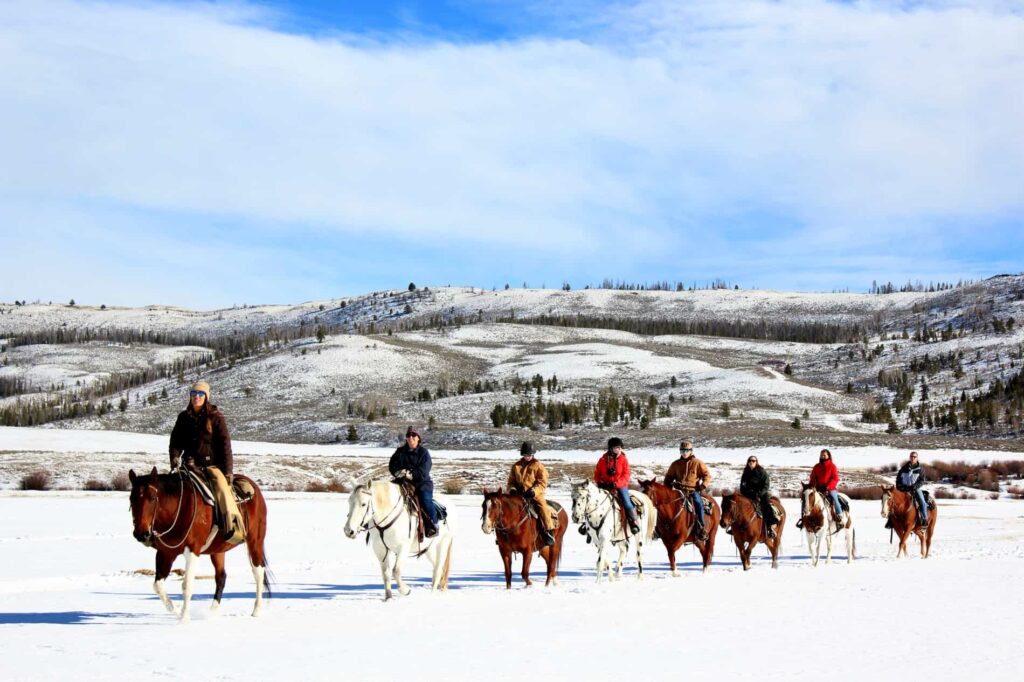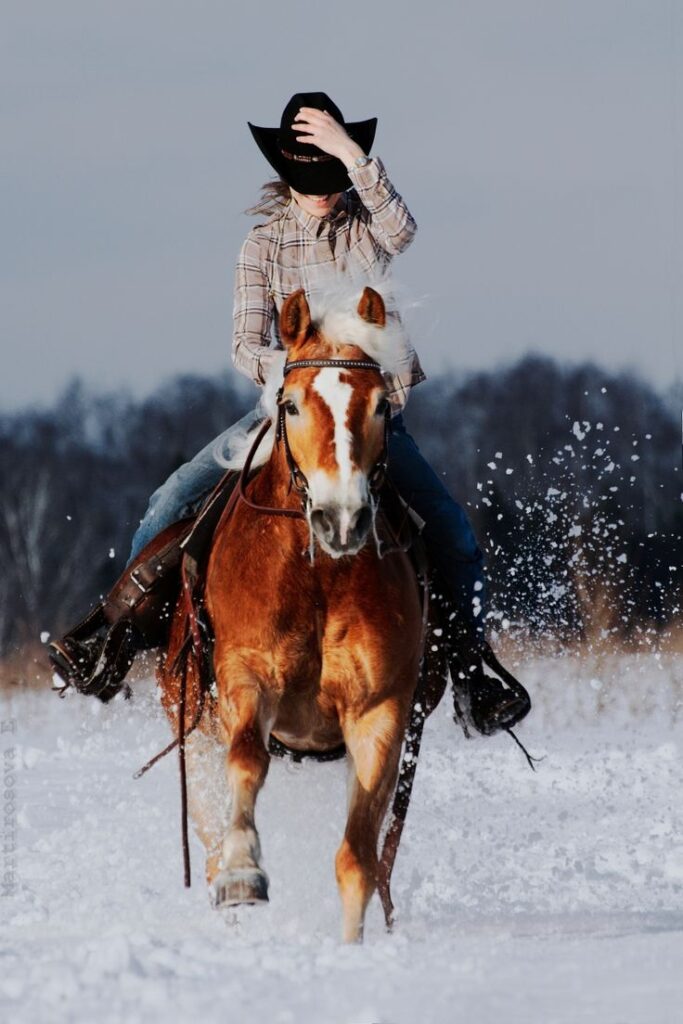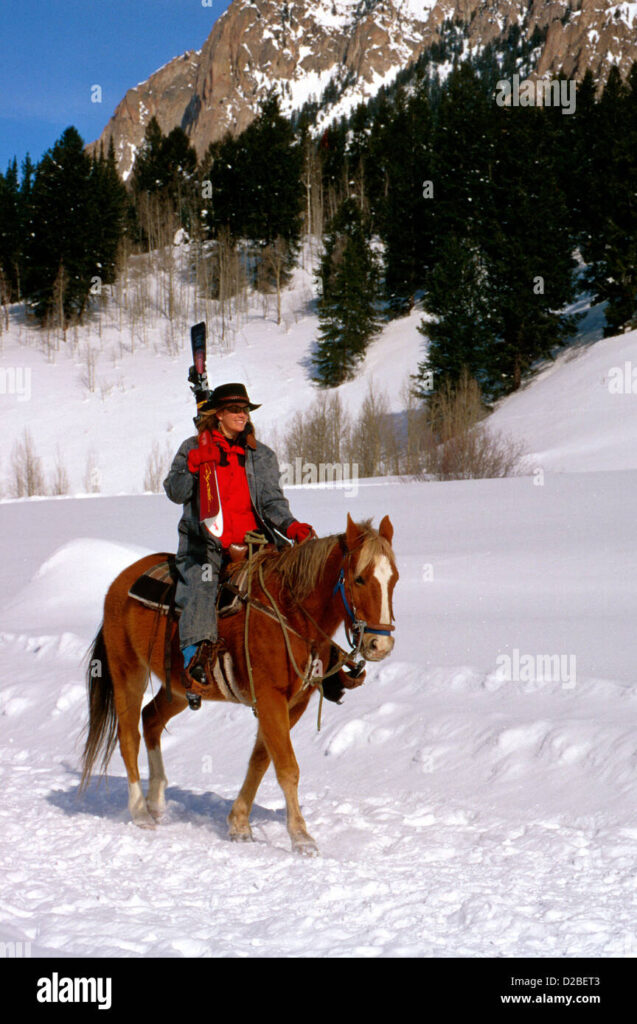Imagine the beauty of horseback riding in the snow, surrounded by the serene white landscape as you gallop through the winter wonderland. It’s a scene straight out of a fairytale, where the sound of hooves hitting the crisp snow creates a rhythmic melody. With each breath, you can see your warm breath dissipate into the cold air, adding to the magical atmosphere. Horseback riding in the snow not only allows you to experience the exhilaration of riding but also offers a unique and breathtaking perspective of nature’s winter beauty. So hop on your trusty steed and let’s embark on an unforgettable snowy adventure.

Benefits of Horseback Riding in the Snow
Horseback riding in the snow offers a unique and thrilling experience, with numerous benefits for both your physical and mental well-being. Here are some reasons why you should consider hitting the snowy trails on horseback:
Physical Exercise
Riding a horse in the snow requires physical exertion and is an excellent form of exercise. As you navigate through the uneven terrain and withstand the cold weather, your body engages various muscle groups, improving your strength and endurance. The act of riding itself also helps to improve posture, balance, and overall flexibility.
Mental Relaxation
There’s no denying the calming effect of being surrounded by the peaceful beauty of a winter landscape. Riding a horse in the snow provides an opportunity to escape the hustle and bustle of daily life and connect with nature. The rhythmic movement of the horse and the tranquility of the surroundings can have a soothing effect on your mind, reducing stress and promoting relaxation.
Connection with Nature
Snowy trails offer a completely different experience compared to riding in other seasons. The pristine white landscapes, glistening snowflakes, and quietude create a serene atmosphere that allows for a deeper connection with nature. As you explore the winter wonderland on horseback, you have the chance to witness breathtaking views, observe wildlife, and appreciate the beauty of the natural world in a whole new way.
Improved Balance and Coordination
Navigating through snow-covered terrain challenges your balance and coordination skills. The constantly shifting and slippery surface require you to adjust your body position and maintain control of your horse. By regularly practicing snow riding, you can enhance your ability to stay balanced and in control, both on and off the horse.
Preparing Yourself and Your Horse for Snow Riding
Before embarking on a snowy horseback riding adventure, it’s crucial to make necessary preparations to ensure a safe and enjoyable experience. Here are some essential steps to take:
Choosing the Right Attire
Dressing appropriately for snow riding is vital to keep yourself warm and protected from the winter elements. Start with wearing layers of clothing that can be easily added or removed depending on the weather conditions. Opt for thermal base layers, insulating mid-layers, and a waterproof outer layer. Don’t forget to wear a warm hat, gloves, and insulated boots to keep your extremities warm.
Equipping Your Horse
Your horse’s comfort and safety are equally important. Make sure your horse is properly blanketed to keep them warm and protected from the cold. Use a blanket that is suitable for the temperature and activity level. Additionally, consider using leg protection like bell boots or splint boots to prevent injuries from icy or uneven terrain.
Preparing the Riding Area
Before heading out on your snowy ride, ensure that the riding area is safe and suitable for riding. Remove any obstacles such as fallen branches or rocks that might pose a threat to you and your horse. It’s also a good idea to mark trails and paths to ensure visibility and prevent getting lost in the winter landscape.
Safety Measures
Horseback riding can be inherently risky, and riding in the snow adds an extra level of challenge. It’s important to prioritize safety by wearing a properly fitted helmet and riding with a reliable and well-trained horse. Always let someone know about your riding plans and carry a fully charged cell phone in case of emergencies. Additionally, consider riding with a buddy for added security and to enhance the overall experience.
Recommended Horse Breeds for Snow Riding
Not all horse breeds are equally suited for snow riding. Some breeds have natural characteristics that make them more adaptable to cold weather conditions and slippery terrains. Here are a few horse breeds to consider for your snowy adventures:
Cold-Weather Adapted Breeds
Certain horse breeds have developed adaptations to thrive in colder climates. Breeds like the Icelandic Horse and the Norwegian Fjord Horse have thick winter coats and a stocky build, making them well-suited for snowy conditions. These breeds also have a sure-footed nature, allowing them to navigate through slippery terrain more effectively.
Horses with Strong Hooves
Snow can be particularly treacherous for horses with weak hooves. Breeds like the Connemara Pony and the Morgan Horse are known for their excellent hoof strength, making them more stable and less prone to slipping on icy surfaces. Their solid and well-shaped hooves provide better traction, ensuring a safer ride in snowy conditions.
Endurance Breeds
When riding in snowy and cold conditions, endurance becomes a crucial factor. Breeds such as the Arabian Horse and the Appaloosa have a natural ability for endurance riding. They have efficient cardiovascular systems and are known for their stamina, allowing them to brave the cold weather and longer rides in the snow.
Snow Riding Techniques
Riding in the snow requires some adjustments to your regular riding style to ensure both your and your horse’s safety. Here are some techniques to consider:
Adjusting Your Riding Style
Snow can create a more challenging riding surface, requiring riders to adjust their position and riding technique. To maintain balance and stability, lean slightly forward and keep your weight centered over the horse’s withers. Apply gentle and controlled pressure on the reins to communicate with your horse while supporting their balance on the slippery terrain.
Mastering Rides in Different Snow Conditions
Snow conditions can vary greatly, ranging from deep powder to packed and icy snow. Each condition requires different riding techniques. In deep snow, allow your horse to find their balance and maintain a slower pace to prevent exhaustion. On packed snow or ice, reduce your speed and make wider turns to maintain stability. Practice riding in various snow conditions to improve your skills and adaptability.
Maintaining Balance in Slippery Terrain
Snow-covered trails and icy patches can be slippery, making balance and stability crucial. Engaging your core muscles and keeping your lower body relaxed can help you maintain balance. Additionally, actively engage your legs and distribute your weight evenly to support your horse’s balance. When riding downhill, shift your weight back slightly to prevent your horse from slipping.

Exploring Winter Landscapes on Horseback
One of the greatest joys of horseback riding in the snow is the opportunity to explore breathtaking winter landscapes. Here are some sights and experiences you can look forward to:
Snow-Covered Forest Trails
Venturing into snow-covered forests on horseback provides a magical experience. The towering trees adorned with glistening snow, the peaceful ambiance, and the soft crunch of snow beneath your horse’s hooves create a serene and unforgettable ride. Take in the beauty of nature as you navigate through winding trails and discover hidden surprises along the way.
Winter Wildlife Encounters
Snowy landscapes offer a unique opportunity to spot wildlife in their natural habitats. As you quietly ride through the snow-covered countryside, you may come across deer, foxes, rabbits, or even certain bird species that are more active during the winter months. Observing these creatures in their winter settings can be an awe-inspiring and educational experience.
Photography Opportunities
Horseback riding in the snow presents fantastic photo opportunities for both amateur and professional photographers. Capture the stunning contrast between the white snow and the vibrant colors of your horse’s coat, or photograph the picturesque winter scenery around you. Remember to respect the wildlife and environment while taking photos and avoid disturbing any natural habitats.
Winter-Specific Challenges and How to Overcome Them
Riding in the snow comes with unique challenges that riders must be prepared to face. Here are some common winter-specific challenges and how to overcome them:
Dealing with Cold Temperatures
Cold temperatures can be uncomfortable and even dangerous if proper precautions are not taken. Dress in layers to trap body heat and ensure you have warm outerwear. Protect your extremities with insulated gloves, hats, and warm socks. Stay hydrated by drinking warm fluids and take regular breaks to warm up if needed. Plan your rides during the warmest parts of the day and be aware of signs of hypothermia or frostbite in both you and your horse.
Managing Ice and Icy Paths
Icy paths can pose a significant risk to both rider and horse. To improve traction, consider using horseshoes with adaptors that provide additional grip on icy surfaces. Avoid riding on extremely icy trails and opt for safer, cleared paths if available. Take your time and be cautious when crossing icy patches, maintaining a slower pace and utilizing your horse’s natural balance and agility.
Avoiding Snow-Induced Injuries
Snow-covered terrain can hide potential hazards or uneven ground. Be vigilant and watch for hidden obstacles such as fallen branches or rocks. Before starting your ride, inspect the area for any potential dangers and clear them if possible. Maintain a safe distance from frozen bodies of water to avoid accidents or your horse stepping into thin ice. Properly fitted leg protection can also help prevent injuries from snowballs or icy ground.

Different Horse Riding Activities in the Snow
Snow riding offers various enjoyable activities beyond trail riding. Here are a few ideas to diversify your winter riding experience:
Snow Trail Riding
Exploring the snowy trails on horseback is the most common and accessible activity in the winter. Whether you prefer a leisurely ride or a more adventurous journey, there are plenty of trails suitable for horseback riding. Enjoy the tranquility of the winter landscape, bond with your horse, and take in the mesmerizing scenery as you venture through the snowy wilderness.
Horse-drawn Sleigh Rides
For a romantic and nostalgic winter activity, consider a horse-drawn sleigh ride. Bundle up in warm blankets as you glide through snow-covered fields or forests, pulled by a team of beautiful horses. This traditional mode of transportation adds a touch of charm and can be a delightful experience for couples, families, or even larger groups.
Participating in Winter Festivals
Many winter festivals and celebrations offer horse-related activities to enjoy. From parades and processions to equestrian games and competitions, these events provide entertainment and a chance to showcase the beauty and versatility of horses. Look for winter festivals in your area that include horseback riding or horse-related events to add a touch of excitement to your snowy adventures.
Snow Riding Gear and Equipment
Having the right gear and equipment is essential for a safe and comfortable snow riding experience. Here are some key items to consider:
Appropriate Footwear for Riders
Investing in warm and insulated boots specifically designed for winter riding is crucial. Look for boots with a good grip, waterproofing, and insulation to keep your feet warm and dry even in the snow. Choose a style that also provides ankle support and a comfortable fit to ensure stability and prevent accidents or strain.
Protection for the Horse’s Legs
Using leg protection for your horse is particularly important when riding in the snow. Bell boots, which cover the horse’s hooves and part of the pastern, can help prevent injuries from ice or snowballs accumulating in the hooves. Splint boots or brushing boots can provide additional support and protection to the horse’s legs, reducing the risk of injuries from uneven terrain.
Winter Horse Tack and Saddles
Ensure your horse’s tack and saddle are suitable for winter riding. Use a saddle pad with moisture-wicking properties to prevent sweat from soaking through and causing discomfort to your horse. Consider using a breastplate or a crupper to prevent the saddle from sliding during rides on slippery surfaces. Regularly clean and inspect your tack to ensure its durability and reliability in winter conditions.

Winter Horse Care Tips
Taking care of your horse during the winter months requires a few additional considerations. Here are some tips to ensure your horse remains healthy and comfortable:
Proper Hydration and Feeding
Cold temperatures can increase your horse’s water and food requirements. Make sure your horse has access to clean, unfrozen water at all times. Consider using heated water buckets or tanks to prevent freezing. Adjust your horse’s diet to accommodate their increased energy needs in cold weather, providing sufficient forage and potentially supplementing with grain or additional calories if necessary. Consult with your veterinarian or equine nutritionist for specific dietary recommendations based on your horse’s needs.
Stable Management in Cold Conditions
If your horse is stabled during the winter, ensure that the barn is well-ventilated but free from drafts. Provide sufficient bedding to insulate from the cold ground and offer extra blankets or sheets to keep your horse warm. Regularly check for signs of frostbite or other cold-related issues, paying particular attention to the extremities such as ears, tail, and hooves. Maintain a regular exercise routine to prevent stiffness and promote circulation.
Protecting Hooves from Snow and Ice
Snow and ice can cause various issues for your horse’s hooves, including trapped moisture and potential injuries from slipping or snowballs accumulating in the hooves. Regular hoof care, including regular trimming and inspection, is vital during winter. Consider using hoof boots or applying sole packing to provide additional protection and support to your horse’s hooves. Remove any compacted snow or ice from the hooves before and after rides to prevent discomfort or slipping.
Winter Riding Safety Guidelines
Safety should always be a top priority when horseback riding, and it becomes even more critical in winter conditions. Here are some safety guidelines to follow:
Riding with a Buddy
Whenever possible, ride with a partner or a group. Riding with a buddy increases safety and provides immediate assistance in case of emergencies. If riding alone is necessary, make sure someone knows your plans and expected return time. Check-in with them after your ride to let them know you’re safe.
Checking Weather Conditions
Stay informed about weather forecasts before heading out for a winter ride. Avoid riding during extreme weather conditions, such as heavy snowfall, freezing rain, or strong winds. Be aware of any potential weather changes during your ride and adjust your plans accordingly.
Emergency Preparedness
Carry a fully charged cell phone with you at all times during your ride. It can be a lifesaver in case of emergencies. Consider downloading a reliable trail mapping app or bringing a physical map to navigate your trail. Pack a basic first aid kit, including bandages, antiseptics, and any necessary medications for both you and your horse. Familiarize yourself with basic first aid procedures and know how to handle common emergencies.
By following these safety guidelines and prioritizing preparedness, you can enjoy your winter horseback riding adventures with peace of mind.
10 Common Questions and Answers about Horseback Riding
- Is horseback riding in the snow safe?
Yes, horseback riding in the snow can be safe if proper precautions are taken. It is essential to dress appropriately, choose the right trail, and use proper equipment to ensure a safe and enjoyable ride.
- What should I wear when riding in the snow?
When riding in the snow, dress in layers to stay warm. Wear thermal base layers, insulating mid-layers, and a waterproof outer layer. Don’t forget to wear a warm hat, gloves, and insulated boots.
- How do I prepare my horse for snow riding?
Prepare your horse for snow riding by blanketing them appropriately to keep them warm. Use leg protection to prevent injuries. Ensure their hooves are properly cared for and consider using traction devices like horseshoes with adaptors for better grip.
- Are there certain horse breeds better suited for snow riding?
Yes, certain horse breeds are better adapted to snowy conditions. Breeds like the Icelandic Horse, Norwegian Fjord Horse, Connemara Pony, and Morgan Horse are known for their cold-weather adaptability and strong hooves.
- How do I adjust my riding style for snow riding?
To adjust your riding style for snow riding, maintain a slightly forward position to help with balance. Apply controlled pressure on the reins and engage your legs to support your horse’s balance. Lean back slightly when riding downhill to prevent slipping.
- What are some winter-specific challenges in snow riding?
Winter-specific challenges in snow riding include cold temperatures, icy paths, and snow-induced injuries. It’s crucial to dress appropriately, manage ice carefully, and watch out for hidden obstacles to overcome these challenges.
- Can I ride my horse on icy trails?
Riding on icy trails can be risky. It’s best to avoid extremely icy paths and opt for cleared trails or paths with better traction. Using horseshoes with adaptors or stud attachments for extra grip can also help manage icy terrain.
- What are some activities I can do on horseback in the snow?
In addition to snow trail riding, you can enjoy horse-drawn sleigh rides or participate in winter festivals that offer horse-related activities. These activities add excitement and variety to your winter horseback riding experience.
- How can I keep my horse’s legs protected in the snow?
To protect your horse’s legs in the snow, consider using bell boots to prevent injuries from icy or snowball-prone terrain. Splint boots or brushing boots can also provide additional support and protection.
- What are some winter care tips for horses?
Ensure proper hydration and feeding by providing clean, unfrozen water and adjusting your horse’s diet according to their energy needs. Maintain a well-ventilated but draft-free stable, and protect your horse’s hooves from snow and ice. Regular hoof care and exercise are also essential during winter.

